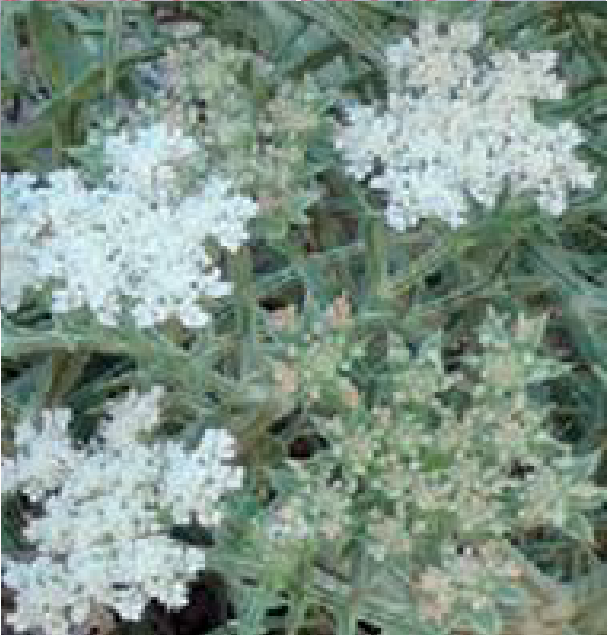Antimicrobial and antioxidant activity of methanol extract of Echinophora spinosa L. from Jijel, Algeria
Main Article Content
Abstract
In this study, the antioxidant and antimicrobial activities of Echinophora spinosa were investigated. Antimicrobial activity of methanol extracts obtained from Echinophora spinosa was examined using the disc diffusion method. Antioxidant activity of the methanol extracts was examined using the stable 2,2-diphenyl-1-picrylhydrazyl (DPPH) radical scavenging test. Methanol extract of ripe fruits of E. spinosa showed highest total phenolic content (69.17 ± 1.2 µg GAE/mg extract) and the major flavonoid contents (12.122 ± 0.44 µg QE/mg extract) was found in leaves of the plant. In disk diffusion antimicrobial assay, E. spinosa manifested broad spectrum of activity. The largest capacity to neutralize DPPH radicals was found for ripe fruits methanol extract of E. spinosa plant. The results shows that the various parts of E. spinosa extracts promising antioxidant and antimicrobial activities have potential bioactivities due to high content of phenolic and flavonoid compounds.
Article Details
References
El Mokni R. Echinophora spinosa L. (Apiaceae), a new species in the flora of Tunisia and second report from North Africa. Hacquetia. 2020, 19 ;1: 137–142. DOI: https://doi.org/10.2478/hacq-2019-0016
Khennouf H, Chefrour A, Corcket E, Alard D, Véla E. La végétation dunaire du littoral de Jijel (Algérie) : proposition d’une nouvelle zone importante pour les plantes. Revue d’Ecologie (Terre et Vie). 2018, 73; 3: 345-362. DOI: https://doi.org/10.3406/revec.2018.1940
Quézel P, Santa S. Nouvelle flore d’Algérie et des régions désertiques méridionales. Ed. CRNS, Paris (FR). 1962‐1963.
Fraternale D, Genovese S, Ricci D. Essential Oil Composition and Antimicrobial Activity of Aerial Parts and Ripe Fruits of Echinophora spinosa (Apiaceae) from Italy. Natural Product Communications. 2013, 8;4: 527 – 530. DOI: https://doi.org/10.1177/1934578X1300800431
Cakilcioglu U, Turkoglu I. An ethnobotanical survey of medicinal plants in Sivrice (Elazıg-Turkey). J Ethnopharmacol. 2010, 132:165–175. DOI: https://doi.org/10.1016/j.jep.2010.08.017
Pavela R, Maggi F, Cianfaglione K, Canale A, Benelli G. Promising insecticidal efficacy of the essential oils from the halophyte Echinophora spinosa (Apiaceae) growing in Corsica Island, France. Environmental Science and Pollution Research. 2019, https://doi.org/10.1007/s11356-019-04980-y. DOI: https://doi.org/10.1007/s11356-019-04980-y
Glamoclija JM, Sokovic MD, Šiljegovic JD, et al. Chemical Composition and Antimicrobial Activity of Echinophora spinosa L. (Apiaceae) Essential Oil. Rec. Nat. Prod. 2011, 5;4: 319-323.
Ngahang Kamte SL, Ranjbarian F, Cianfaglione K. et al. Identification of highly effective antitrypanosomal compounds in essential oils from the Apiaceae family. Ecotoxicology and Environmental Safety. 2018, 156: 154–165. DOI: https://doi.org/10.1016/j.ecoenv.2018.03.032
Pavela R, Maggi F, Cianfaglione K, Bruno M, Benelli G. Larvicidal Activity of Essential Oils of Five Apiaceae Taxa and Some of Their Main Constituents Against Culex quinquefasciatus. Chem. Biodiversity. 2018, 15, e1700382. DOI: https://doi.org/10.1002/cbdv.201700382
Naz R Ayub H Nawaz S. et al. Antimicrobial activity, toxicity and antiinflammatory potential of methanolic extracts of four ethnomedicinal plant species from Punjab, Pakistan. BMC Complementary and Alternative Medicine. 2017, 17:302 DOI 10.1186/s12906-017-1815-z DOI: https://doi.org/10.1186/s12906-017-1815-z
Khouchlaa A, Talbaoui A, El Yahyaoui El Idrissi A. et al. Détermination des composés phénoliques et évaluation de l’activité litholytique in vitro sur la lithiase urinaire d’extrait de Zizyphus lotus L. d’origine marocaine. Phytothérapie. 2017, https://doi.org/10.1007/s10298-017-1106-3. DOI: https://doi.org/10.1007/s10298-017-1106-3
Elija K, Adsul VB, Kulkarni MM, Deshpande NR, Kashalkar RV. Spectroscopic determination of total phenol and flavonoid contents of Ipomoea carnea. International Journal of ChemTech Research. 2010, 2;3: 1698–1701.
NCCLS. Performance Standards for Antimicrobial Disk and Dilution Susceptibility Tests for Bacteria Isolated from Animals; Approved Standard—Second Edition. NCCLS document M31-A2 (ISBN 1-56238-461-9). NCCLS, 940 West Valley Road, Suite 1400, Wayne, Pennsylvania 19087-1898, USA. 2002.
CLSI. Method for Antifungal Disk Diffusion Susceptibility Testing of Nondermatophyte Filamentous Fungi; Approved Guideline. CLSI document M51-A (ISBN 1-56238-752-1). Clinical and Laboratory Standards Institute. 2010.
NCCLS. Method for Antifungal Disk Diffusion Susceptibility Testing of Yeasts; Approved Guideline. NCCLS document M44-A (ISBN 1-56238-532-1). NCCLS, 940 West Valley Road, Suite 1400, Wayne, Pennsylvania 19087-1898 USA. 2004.
Chahardoli A, Karimi N, Ma X, Qalekhani F. Effects of engineered aluminum and nickel oxide nanoparticles on the growth and antioxidant defense systems of Nigella arvensis L. Sci Rep. 2020, 10; 3847. https://doi.org/10.1038/s41598-020-60841-6. DOI: https://doi.org/10.1038/s41598-020-60841-6
Tamert A, Latreche A, Aouad L. Phytochemical Screening and Antimicrobial Activity of Extracts of Thymus serpyllum and Thymus vulgaris from the Mount of Tessala (Western Algeria). Phytothérapie. 2017, 15:384-394; DOI 10.1007/s10298-017-1132-1 DOI: https://doi.org/10.1007/s10298-017-1132-1
Chávez-González ML, Sepúlveda L, Verma DK, et al. Conventional and Emerging Extraction Processes of Flavonoids. Processes. 2020, 8, 434; doi:10.3390/pr8040434 DOI: https://doi.org/10.3390/pr8040434
Najjaa H, Abdelkarim BA, Doria E, et al. Phenolic composition of some Tunisian medicinal plants associated with anti-proliferative effect on human breast cancer MCF-7 cells. The EuroBiotech Journal. 2020, 4;2: 104-112. DOI: https://doi.org/10.2478/ebtj-2020-0012
Yahia Y, Bagues M, Zaghdoud C, Al-Amri SM, Nagaz K, Guerfel M. Phenolic profile, antioxidant capacity and antimicrobial activity of Calligonum arich L., desert endemic plant in Tunisia. South African Journal of Botany. 2019, 124:414–419. https://doi.org/10.1016/j.sajb.2019.06.005 DOI: https://doi.org/10.1016/j.sajb.2019.06.005
Das P, Hasnu S, Lahkar L, Mahanta S, Borthakur SK, Tanti B. Antimicrobial activity and antioxidant properties of Brucea mollis Wall. ex Kurz: a medicinal plant of Northeast India. Advances in Traditional Medicine. 2020, https://doi.org/10.1007/s13596-020-00494-y. DOI: https://doi.org/10.1007/s13596-020-00494-y
Lahmass I, Ouahhoud S, Elmansuri M, et al. Determination of Antioxidant Properties of Six By-Products of Crocus sativus L. (Saffron) Plant Products. Waste Biomass Valor. 2018, 9:1349–1357. DOI: https://doi.org/10.1007/s12649-017-9851-y
Abdel-Aleem ER, Attia EZ, Farag FF, Samy MN, Desoukey SY. Total phenolic and flavonoid contents and antioxidant, anti-inflammatory, analgesic, antipyretic and antidiabetic activities of Cordia myxa L. leaves, Clin Phytosci. 2019, 5; 29. https://doi.org/10.1186/s40816-019-0125-z. DOI: https://doi.org/10.1186/s40816-019-0125-z
Goswami S, Das R, Ghosh P, Chakraborty T, Barman A, Ray, S. Comparative antioxidant and antimicrobial potentials of leaf successive extract fractions of poison bulb, Crinum asiaticum L. Industrial Crops & Products. 2020, 154 112667, https://doi.org/10.1016/j.indcrop.2020.112667. DOI: https://doi.org/10.1016/j.indcrop.2020.112667


